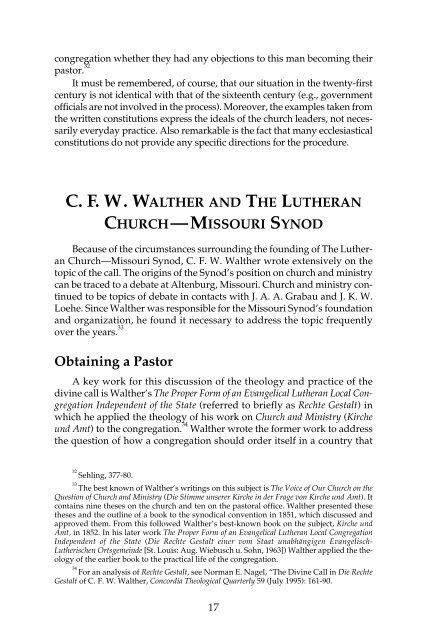45930 Divine Call CTCR final - The Lutheran Church—Missouri Synod
45930 Divine Call CTCR final - The Lutheran Church—Missouri Synod
45930 Divine Call CTCR final - The Lutheran Church—Missouri Synod
You also want an ePaper? Increase the reach of your titles
YUMPU automatically turns print PDFs into web optimized ePapers that Google loves.
congregation whether they had any objections to this man becoming their<br />
pastor. 32<br />
It must be remembered, of course, that our situation in the twenty-first<br />
century is not identical with that of the sixteenth century (e.g., government<br />
officials are not involved in the process). Moreover, the examples taken from<br />
the written constitutions express the ideals of the church leaders, not necessarily<br />
everyday practice. Also remarkable is the fact that many ecclesiastical<br />
constitutions do not provide any specific directions for the procedure.<br />
C. F. W. WALTHER AND THE LUTHERAN<br />
CHURCH—MISSOURI SYNOD<br />
Because of the circumstances surrounding the founding of <strong>The</strong> <strong>Lutheran</strong><br />
<strong>Church—Missouri</strong> <strong>Synod</strong>, C. F. W. Walther wrote extensively on the<br />
topic of the call. <strong>The</strong> origins of the <strong>Synod</strong>’s position on church and ministry<br />
can be traced to a debate at Altenburg, Missouri. Church and ministry continued<br />
to be topics of debate in contacts with J. A. A. Grabau and J. K. W.<br />
Loehe. Since Walther was responsible for the Missouri <strong>Synod</strong>’s foundation<br />
and organization, he found it necessary to address the topic frequently<br />
over the years. 33<br />
Obtaining a Pastor<br />
A key work for this discussion of the theology and practice of the<br />
divine call is Walther’s <strong>The</strong> Proper Form of an Evangelical <strong>Lutheran</strong> Local Congregation<br />
Independent of the State (referred to briefly as Rechte Gestalt) in<br />
which he applied the theology of his work on Church and Ministry (Kirche<br />
und Amt) to the congregation. 34 Walther wrote the former work to address<br />
the question of how a congregation should order itself in a country that<br />
32<br />
Sehling, 377-80.<br />
33<br />
<strong>The</strong> best known of Walther’s writings on this subject is <strong>The</strong> Voice of Our Church on the<br />
Question of Church and Ministry (Die Stimme unserer Kirche in der Frage von Kirche und Amt). It<br />
contains nine theses on the church and ten on the pastoral office. Walther presented these<br />
theses and the outline of a book to the synodical convention in 1851, which discussed and<br />
approved them. From this followed Walther’s best-known book on the subject, Kirche und<br />
Amt, in 1852. In his later work <strong>The</strong> Proper Form of an Evangelical <strong>Lutheran</strong> Local Congregation<br />
Independent of the State (Die Rechte Gestalt einer vom Staat unabhängigen Evangelisch-<br />
Lutherischen Ortsgemeinde [St. Louis: Aug. Wiebusch u. Sohn, 1963]) Walther applied the theology<br />
of the earlier book to the practical life of the congregation.<br />
34<br />
For an analysis of Rechte Gestalt, see Norman E. Nagel, “<strong>The</strong> <strong>Divine</strong> <strong>Call</strong> in Die Rechte<br />
Gestalt of C. F. W. Walther, Concordia <strong>The</strong>ological Quarterly 59 (July 1995): 161-90.<br />
17


